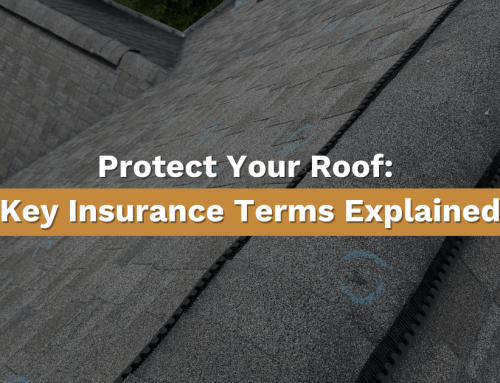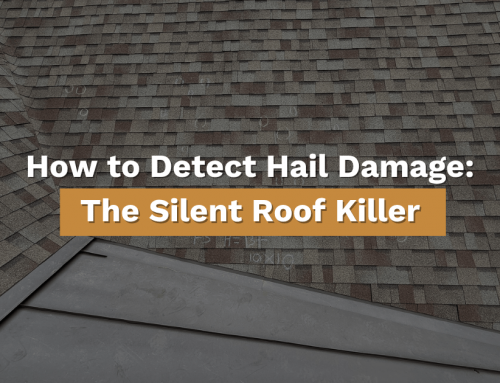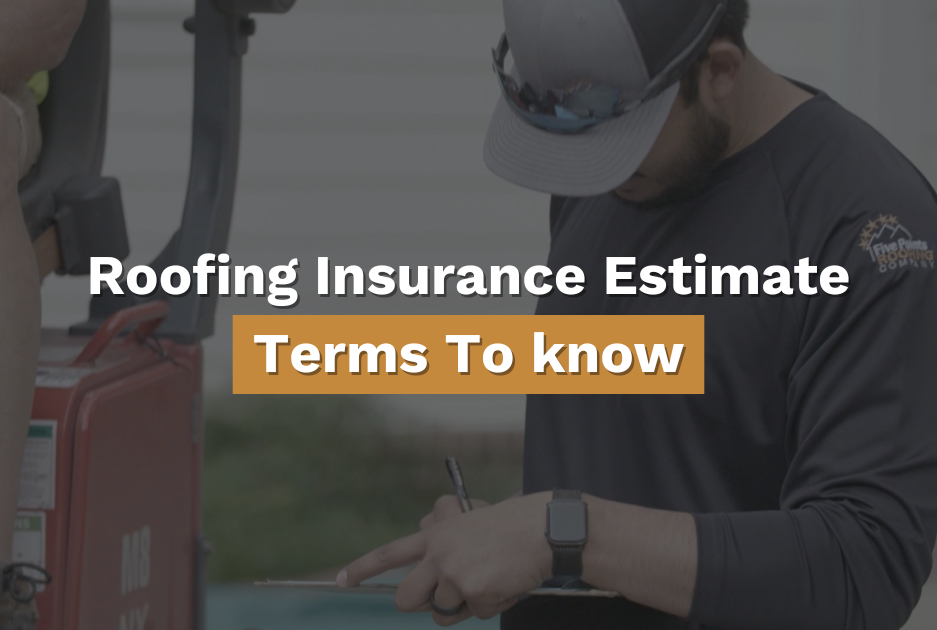
Highlights for Insurance Terms
Home insurance protects against unexpected events like storms and accidents. Key terms: Replacement Cost Coverage (RCV) covers repairs without depreciation, while Actual Cash Value (ACV) factors in depreciation, raising out-of-pocket costs. Roof Payment Schedule (RPS) policies are cheaper but shift more cost to homeowners.
Table of Contents
Understanding Insurance Coverage
Insurance coverage is crucial to homeownership, providing financial protection against unexpected events such as natural disasters, theft, and accidents. Understanding the different types of insurance coverage is essential to ensure you have the proper protection for your home and belongings. Whether safeguarding your property from wind or hail damage or ensuring you have the funds to replace stolen items, having the right insurance coverage can make all the difference in times of need.
What is Replacement Cost Coverage?
Replacement cost coverage is insurance coverage that pays for replacing or repairing damaged or destroyed property with new materials of similar quality. Unlike actual cash value coverage, which factors in depreciation, replacement cost coverage ensures that you can restore your home to its original condition without worrying about the age of the materials. Although this coverage is usually more expensive, it provides more comprehensive protection for homeowners. With replacement cost coverage, the insurance carrier will cover the total cost of replacing or repairing damaged property, giving you peace of mind that your home can be fully restored after a loss.
What do RCV, ACV, and Depreciation mean on my insurance estimate?
RCV – Replacement Cost Value is the total amount estimated to restore your property to its original state. ACV – Actual Cash Value is the total amount the insurance carrier estimates your property is worth based on age. Depreciation is the dollar amount the insurance carrier deducts from the RCV based on its current condition & age.
Roof Payment Schedule (RPS) policies are designed to provide a more affordable alternative to traditional homeowners insurance policies. These policies often have different coverage limits and may not require deductibles, making them a viable option for certain homeowners.
Coverage Limits refer to the maximum amount an insurance policy will pay for a covered loss. Insurance companies offer various policies, including RPS and standard homeowners insurance policies, allowing homeowners to choose the best plan for their needs.
Let’s Talk About These Insurance Estimate Terms To Know In Detail
When reviewing an insurance estimate, it’s essential to understand the different terms used to describe the coverage and costs. Here are some key terms to know:
-
Replacement Cost Value (RCV): The total amount estimated to repair or replace a property to its original state.
-
Actual Cash Value (ACV): The total amount the insurance carrier estimates a property is worth based on age.
-
Depreciation: The amount the insurance carrier deducts from the RCV based on the property’s current condition and age.
-
Roof Payment Schedule (RPS): A policy that sets a portion of non-recoverable depreciation based on the roof’s age.
-
Deductible: The total amount a homeowner owes out-of-pocket if they file a claim.
-
Coverage Limits: The maximum amount the policy will pay toward a covered loss.
By understanding these terms, homeowners can make informed decisions about their insurance coverage and ensure that they have the right protection for their homes and belongings. Knowing the difference between replacement cost and actual cash value, for instance, can help you choose the best policy for your needs and avoid unexpected expenses.
Navigating these Insurance Terms
Navigating insurance estimate terms can be difficult, but fear not! As a seasoned roofing contractor with an intimate understanding of the insurance industry, we’re here to demystify the jargon and empower you with the knowledge you need to decipher what your insurance company is covering.
Standard homeowners insurance policies often come with limited coverage, meaning they may not adequately protect certain valuables or specific property types, such as those with certain roof types. It’s important to understand these coverage limitations and consider seeking additional endorsements or separate policies to enhance protection for valuable items and unique property situations.
Let’s dive right in:
RCV – Replacement Cost Value:
When we mention RCV, we’re referring to the “replacement cost value” of your loss. It’s the comprehensive estimate to restore or replace your damaged property to its original glory. Most good insurance policies use this value as the total amount they pay after all repairs are completed.
Replacement coverage, on the other hand, allows homeowners to repair or replace damaged property without factoring in depreciation, ensuring that claims reimburse the current cost of similar items or materials. This differs from actual cash value coverage, which considers depreciation and reimburses the homeowner for the item’s current market value.
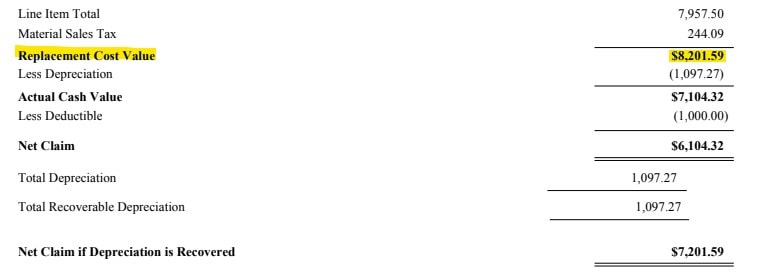
ACV – Actual Cash Value:
ACV, on the other hand, stands for the “actual cash value” of your loss. This amount is based on your property’s worth determined by its age. Most homeowners insurance policies use ACV, which means the reimbursement amount can be significantly lower due to depreciation. ACV can sway your insurance estimate in two primary ways:
For RCV Policies:
If you’re on an RCV policy, your ACV total is what the insurance carrier initially pays after you file your claim until repairs wrap up. Post-proof of completion (photos and documentation should be provided by your contractor), the carrier releases the difference between ACV and RCV (depreciation) – in a separate payment.
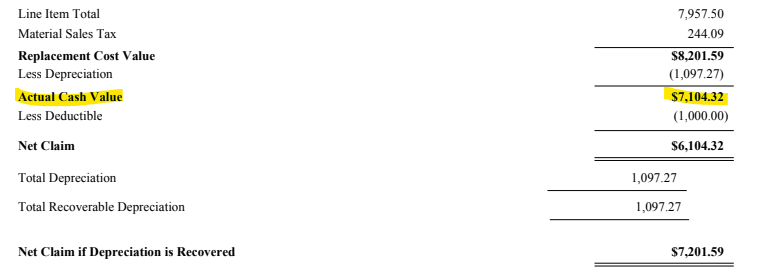
In the above example, the homeowner will receive an initial check with this estimate for $6,104.32. This total is the ACV less their deductible. Once repairs are completed and the contractor sends a notice of completion to the carrier, the depreciation, in the amount of $1,097.27, will be paid.
For ACV Policies:
With these policies (familiar with Allstate and Farm Bureau), you’ll foot the bill for both your deductible and the percentage of the total replacement cost that’s considered “depreciable.” For instance, if your replacement cost is $10,000.00, your deductible is $1,000.00, and the carrier depreciates your roof by 30% due to age ($3,000.00), you’re looking at an out-of-pocket expense of $4,000.00.

In the above example, the customer has an ACV policy. Here, they are responsible for paying $4,240.65 plus their $1,000.00 deductible to their contractor.
Non-Recoverable Depreciation:
Non-recoverable depreciation is the difference between RCV and ACV that the carrier does not owe for. That is typically found on ACV policies written by Farm Bureau and Allstate. Whether you complete repairs or not, you are responsible for this cost. This is usually found on lower premium policies. In the case of a covered loss, the carrier is making you pay for the roof’s age.
Some homeowners insurance policies provide limited coverage, which means they may not adequately cover specific types of properties or certain valuables like jewelry. This can leave homeowners needing additional coverage options or separate policies for adequate protection.

In the above example, the insurance carrier is holding back $4,240.65 as the amount they deem has been depreciated from the roof’s value. This amount is not paid to the homeowner, even after completion, and they are responsible for paying that amount directly to the contractor, plus their deductible. That brings the total out-of-pocket cost to the homeowner of $5,240.65.
RPS – Roof Payment Schedule:
RPS policies, employed by insurers like Allstate, craft affordability by design. They set a portion of non-recoverable depreciation based on your roof’s age. If repairs or replacements cost an estimated $10,000.00, your policy outlines what they’ll cover (usually 60% of replacement cost), leaving you responsible for $4,000.00 PLUS your deductible.
It’s important to note that RPS policies may not cover metal roofs, necessitating specialized insurance options for homeowners with this type of roofing.

As you can see in the above example, the “Customer Portion for RPS” is the cost that the carrier passes on to the homeowner in lieu of a smaller premium payment. In this case, the customer is responsible for $14,501.12, not including their deductible. Now you can see why RPS policies, even though they have a much lower premium, aren’t worth the stress of being out-of-pocket for such a high amount in the case of a covered loss.
Recoverable Depreciation:
Recoverable depreciation equals the disparity between RCV and ACV. It’s payable post-repairs, upon validating completion to the carrier. For instance, an RCV policy pegs an estimate at $10,000.00, and they’ve depreciated the roof by 30% ($3,000.00). The $3,000.00 in recoverable depreciation waits until repairs wrap up before the carrier disburses it. It’s a standard practice, and good policies are typically RCV. Consult your agent to clarify your specifics.
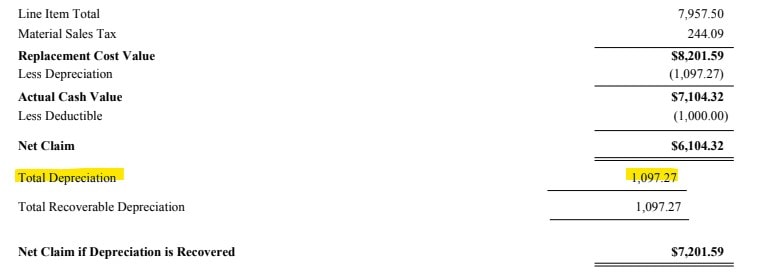
In the above example, the total depreciation of $1,097.27 will be paid to the homeowner after the contractor sends a notice of completion.
Deductible:
When you purchase your policy, the deductible is a significant factor in the policy pricing. You will owe this total out-of-pocket amount if you file a claim. Deductibles are non-negotiable items by law. This means your contractor can not legally waive this amount, and you must pay it directly to them.
Example—You file a roof damage claim, and the agreed-upon damage equals $10,000.00. If you have an RCV policy, and your policy’s deductible is $1,000.00, the maximum you will be out-of-pocket, with the exception of any selected upgrades, is $1,000.00.

In the above ACV Policy example, the customer has a total deductible of $1,000.00. This amount is due to their contractor regardless of their policy type.
Conclusion:
To sum up, insurance estimate terms can be perplexing. RCV policies are the stars, ACV policies can lead to higher expenses, and RPS policies… well, shopping for a new policy with another carrier might be in order. If you have questions about any items on your insurance estimate, your contractor should help explain what they mean in detail. If they can’t do that… shop for another contractor.
Feeling ready to file an insurance claim? Read our How To File A Roof Damage Claim article!


